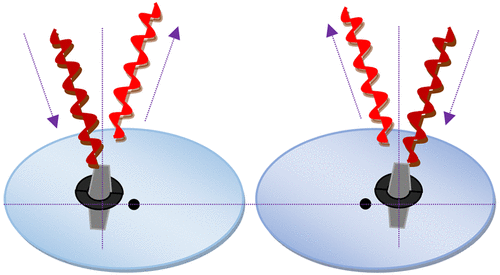当前位置:
X-MOL 学术
›
ACS Appl. Nano Mater.
›
论文详情
Our official English website, www.x-mol.net, welcomes your feedback! (Note: you will need to create a separate account there.)
Gold Nanostructures and Microstructures with Tunable Aspect Ratios for High-Speed Uni- and Multidirectional Photonic Applications
ACS Applied Nano Materials ( IF 5.9 ) Pub Date : 2020-09-11 , DOI: 10.1021/acsanm.0c02022 Mubarak Ali, I-Nan Lin
ACS Applied Nano Materials ( IF 5.9 ) Pub Date : 2020-09-11 , DOI: 10.1021/acsanm.0c02022 Mubarak Ali, I-Nan Lin

|
Structural identifications of different geometrical shapes of gold nanostructures (nanoparticles) and microstructures (particles) are presented here. The nucleation mechanism of nanoparticles and particles having geometrical shapes, which has never been reported before, is discussed here. A dimensional regularity of particles in geometrical shapes is also discussed. Two different zones have been found at an electronically flat solution surface developing tiny-shaped particles in less elongation of atoms and in more elongation of atoms. Tiny-shaped particles in less elongation of atoms develop in the zone consisting of regions rearward to the north pole at the solution surface. They nucleate (and develop) particles of one-dimensional (1D) shapes. Tiny-shaped particles in more elongation of atoms develop in the zone consisting of regions of east–west poles. They nucleate (and develop) particles of multidimensional (MD) shapes. Upon modification or conversion of arrays of tiny-shaped particles into structures of smooth elements, they assemble at a common point to nucleate particles of 1D and MD shapes. A common point is located at the center of concave meniscus, which is also in the center of light glow at solution surface. At an electronically decreasing level solution surface, each structure of smooth element deals with the force in the immersing format. The force exerting in the immersing format is based on the simultaneous action of four forces to a structure of smooth element coming to assemble there. In addition to the acquired orientation of an electron and the position of its atom at the solution surface, the manner of energy knot clamping to an electron in an atom also varies the exertion of force for it. Particles of geometrical shapes show different structures in 1D and MD shapes, so they can deal with the propagation of photons unidirectionally and multidirectionally. Upon identification of the structures of 1D and MD shapes, the mechanism of photon reversion is disclosed. Printing spots of reverted force in photons reflected from the laterally orientated electrons of less and more elongated atoms validate that the photons are not carried by the electrons, so it is a photon reflection instead of an electron diffraction in the selected area patterns of the particles. On the basis of the discussion presented here, the law of reflection in studying the prism/glass surface also needs to be amended.
中文翻译:

具有可调整纵横比的金纳米结构和微结构,用于高速单向和多向光子应用
本文介绍了金纳米结构(纳米颗粒)和微结构(颗粒)的不同几何形状的结构识别。本文讨论了以前从未报道过的纳米粒子和具有几何形状的粒子的成核机理。还讨论了几何形状的粒子的尺寸规则性。在电子平面溶液表面发现了两个不同的区域,这些区域以较小的原子伸长率和较大的原子伸长率产生了微小的颗粒。原子伸长率较小的微小形状的颗粒在溶液表面上由北极后方区域组成的区域中形成。它们成核(并形成)一维(1D)形状的粒子。在由东西两极组成的区域中,原子伸长率更高的微小形状的颗粒形成。它们成核(并形成)多维(MD)形状的粒子。将微小形状的粒子阵列修改或转换为光滑元素的结构后,它们会在一个公共点聚集以使1D和MD形状的粒子成核。一个公共点位于凹弯月面的中心,该点也位于溶液表面的发光中心。在电子递减的溶液表面上,光滑元件的每个结构都以浸入形式处理力。以浸没形式施加的力是基于四个力同时作用于将要在那里组装的光滑元件结构的作用。除了获得的电子方向和其原子在溶液表面的位置之外,将能量结夹紧在原子中的电子的方式也改变了对其施加的力。几何形状的粒子在1D和MD形状中显示出不同的结构,因此它们可以单向和多向处理光子的传播。在确定1D和MD形状的结构后,公开了光子回复的机理。从越来越少的细长原子的横向取向电子反射而来的光子中反向力的印刷点证实,光子不会被电子携带,因此,这是光子反射,而不是粒子的选定区域图案中的电子衍射。根据此处提出的讨论,
更新日期:2020-09-25
中文翻译:

具有可调整纵横比的金纳米结构和微结构,用于高速单向和多向光子应用
本文介绍了金纳米结构(纳米颗粒)和微结构(颗粒)的不同几何形状的结构识别。本文讨论了以前从未报道过的纳米粒子和具有几何形状的粒子的成核机理。还讨论了几何形状的粒子的尺寸规则性。在电子平面溶液表面发现了两个不同的区域,这些区域以较小的原子伸长率和较大的原子伸长率产生了微小的颗粒。原子伸长率较小的微小形状的颗粒在溶液表面上由北极后方区域组成的区域中形成。它们成核(并形成)一维(1D)形状的粒子。在由东西两极组成的区域中,原子伸长率更高的微小形状的颗粒形成。它们成核(并形成)多维(MD)形状的粒子。将微小形状的粒子阵列修改或转换为光滑元素的结构后,它们会在一个公共点聚集以使1D和MD形状的粒子成核。一个公共点位于凹弯月面的中心,该点也位于溶液表面的发光中心。在电子递减的溶液表面上,光滑元件的每个结构都以浸入形式处理力。以浸没形式施加的力是基于四个力同时作用于将要在那里组装的光滑元件结构的作用。除了获得的电子方向和其原子在溶液表面的位置之外,将能量结夹紧在原子中的电子的方式也改变了对其施加的力。几何形状的粒子在1D和MD形状中显示出不同的结构,因此它们可以单向和多向处理光子的传播。在确定1D和MD形状的结构后,公开了光子回复的机理。从越来越少的细长原子的横向取向电子反射而来的光子中反向力的印刷点证实,光子不会被电子携带,因此,这是光子反射,而不是粒子的选定区域图案中的电子衍射。根据此处提出的讨论,



























 京公网安备 11010802027423号
京公网安备 11010802027423号